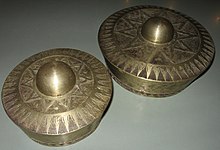Kulintang
Kulintang is a modern term for an ancient instrumental form of music composed on a row of small, horizontally-laid gongs that function melodically, accompanied by larger, suspended gongs and drums. As part of the larger gong-chime culture of Southeast Asia, kulintang music ensembles have been playing for many centuries in regions of the EasternMalay Archipelago—the Southern Philippines, Eastern Indonesia, Eastern Malaysia, Brunei and Timor, although this article has a focus on the Philippine Kulintang tradition of the Maranao and Maguindanao peoples in particular. Kulintang evolved from a simple native signaling tradition, and developed into its present form with the incorporation of knobbed gongs from Sunday. Its importance stems from its association with the indigenous cultures that inhabited these islands prior to the influences ofHinduism, Buddhism, Islam, Christianity or the West, making Kulintang the most developed tradition of Southeast Asian archaic gong-chimeensembles.
Technically, kulintang is the Maguindanao, Ternate and Timor term for theidiophone of metal gong kettles which are laid horizontally upon a rack to create an entire kulintang set. It is played by striking the bosses of the gongs with two wooden beaters. Due to its use across a wide variety groups and languages, the kulintang is also called kolintang by theMaranao and those in Sulawesi, kulintangan, gulintangan by those inSabah and the Sulu Archipelago and totobuang by those in centralMaluku.
By the twentieth century, the term kulintang had also come to denote an entire Maguindanao ensemble of five to six instruments. Traditionally the Maguindanao term for the entire ensemble is basalen or palabunibunyan, the latter term meaning “an ensemble of loud instruments” or “music-making” or in this case “music-making using a kulintang.”



Descrptions
The instrument called the “kulintang” (or its other derivative terms) consist of a row/set of 5 to 9 graduated pot gongs, horizontally laid upon a frame arranged in order of pitch with the lowest gong found on the players’ left. The gongs are laid in the instrument face side up atop two cords/strings running parallel to the entire length of the frame, with bamboo/wooden sticks/bars resting perpendicular across the frame, creating an entire kulintang set called a "pasangan".
The gongs weigh roughly from two pounds to three pounds each, and have dimensions of 6 to 10 inches for their diameters and 3 to 5 inches for their height. Traditionally they were made from bronze but due to the disruption and loss of trade routes between the islands of Borneo and Mindanao during World War II, resulting in loss of access to necessary metal ores, and the subsequent post-war use of scrap metal, brass gongs with shorter decaying tones are now commonplace.
The kulintang frame is known as an "antangan" by the Maguindanao (which means to “arrange”) and "langkonga" by the Maranao.
The kulintang is played by striking the bosses of the gongs with two wooden beaters. When playing the kulintang, the Maguindanao and Maranao would always sit on chairs while for the Tausug/Suluk and other groups that who play the kulintangan, they would commonly sit on the floor.[
Performance
The main purpose for kulintang music in the community is to function as social entertainment at a nonprofessional, folk level.This music is unique in that it is considered a public music in the sense everyone is allowed to participate. Not only do the players play, but audience members are also expected to participate.These performances are important in that they bring people in the community and adjacent regions together, helping unify communities that otherwise may not have interacted with one another. Traditionally, when performers play kulintang music, their participation is voluntary. Musicians see performances as an opportunity to receive recognition, prestige and respect from the community and nothing more.
https://en.wikipedia.org/wiki/Kulintang
No comments:
Post a Comment